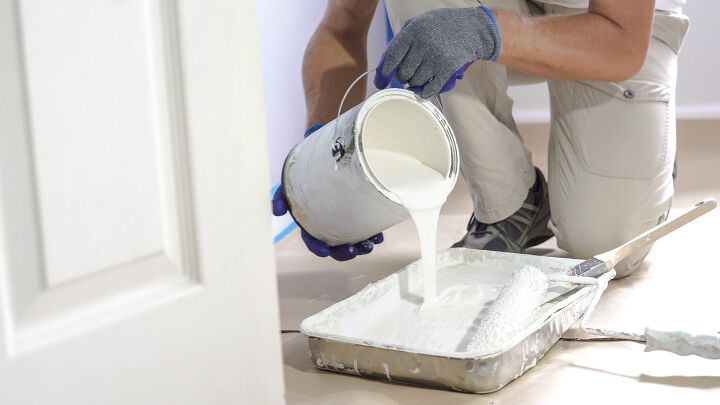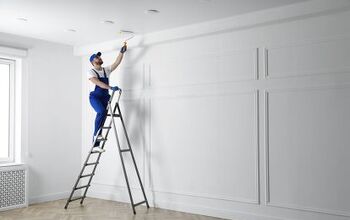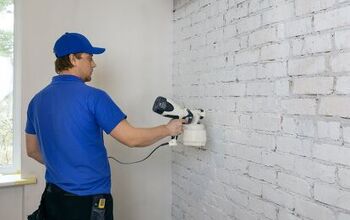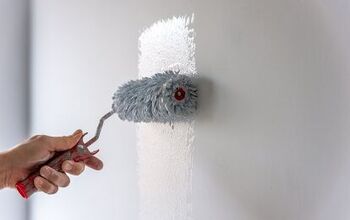Can You Use Acrylic Paint On Walls?

Painting your home is fun! You get to choose different colors and turn your living space into something that feels more like your space rather than the typical white wall.
However, the type of paint matters. Whether it’s to cover the whole wall or paint a mural, many people wonder if you can paint walls with acrylic paints.
You can use acrylic paint to paint your walls, but it might also not adhere to them. You will need to prime the wall, or if creating a mural, you will need to add a bonding agent for the best finish.
If you are unfamiliar with acrylic paints, it’s best to stick to your regular indoor wall paint.
Below we will talk more about painting your walls with acrylic to see if this is something that is feasible to you! Let’s get started.
Can You Paint Your Walls With Acrylic Paint?
Yes, you can use acrylic paint to paint your walls. Because of a wall’s porous surface, acrylic paints allow moisture to evaporate without causing adhesion. Chemical additives are also used to strengthen acrylic paints. And because they dry quickly when applied to walls, they become water-resistant.
If you want to speed up drying, you might also wish to add mediums. However, this paint doesn’t mix well with paints that have an oil base. So, scrape the oil paint off before adding acrylic if you had previously painted with oil.
Its resilience to the sun is what sets this paint apart from other paints. Because of its resistance to intense UV radiation, it is perfect for outdoor projects and indoor.
What Exactly Is Acrylic Paint?
Acrylic paint uses pigment suspended in an acrylic polymer emulsion, defoamers, plasticizers, silicone oils, metal soaps, or stabilizers to create a fast-drying paint.
Although acrylic paints are often water-based, they dry to finishes that are water-resistant. Depending on how much you dilute acrylic paint with water or modify it using acrylic gels, pastes, or mediums, you can make it appear like a water color, gouache, or oil paint.
How Long Does Acrylic Paint Last On Walls?
The fact that acrylic paints are comprised of synthetic ingredients is a plus. This means that, unlike the standard options, these paints rarely expire.
However, the likelihood of them going bad increases if you don’t keep them properly. Acrylic paints should last up to 10 years if not used. However, it can only withstand seven years when used on walls.
It is practical to keep your extra acrylic paints in locations like garages. Doing this can prevent the paint from cracking, drying, and freezing.
Why Does Acrylic Paint Go Bad?
Acrylic is different than other paints and therefore can go bad. Below are some of the reasons that this happens so that maybe you can better prepare.
Mold
Your acrylic paint’s lifespan can be drastically shortened by mold and mildew. If your paint is exposed to any type of moisture, then mold will spread quickly.
Therefore, it would be beneficial if you keep your paint away from any sort of harmful moisture. The suggested range of temperatures for acrylic paint storage and application is 60 to 75 F. (15-24 Celsius). Any temperatures below 45 F (7.2 C) are discouraged.
Extreme Temperatures
Acrylic paints progressively lose value when kept in hot storage. High temperatures cause the paint to lose moisture, deteriorate, crust over, and most likely dry.
However, when exposed to extreme cold, the components of acrylic paints rapidly separate. Since the contents of the paint are compromised by the cold, separation frequently occurs.
How Long Does Acrylic Paint Take To Dry On Walls?
The hardest part of any painting project is waiting for your paint to dry. If your first coat is about to be finished, you might be wondering how long it will take to dry.
Knowing how long to wait between coats is another important consideration. Depending on the circumstances affecting paint drying, the answers to these questions change.
The type of paint you use, the temperature, and humidity all play a role in how quickly your paint dries. Accordingly, the drying time for acrylic paint of acceptable quality is 2 to 3 hours.
To speed up the drying process, your space must also be sufficiently ventilated. You might use additional factors to shorten the drying time. They include heat sources such as hair dryers, lights, heat pistols, and a lot more. However, exercise caution when using the aforementioned items.
Tips To Dry Your Acrylic Paint Safely
Below are some tips that you can apply if you’re looking to dry your acrylic paint without ruining your paint job.
- Wait for the first layer to dry. Your first layer of paint should be dry upon touching before you think about adding a second coat.
- Be patient. You should wait at least 4 hours between coats of paint before adding another.
- Keep paint away from your heater. Your paint is flammable, and even though it’s unlikely, your wall can still catch fire if it gets too warm.
- Don’t let the paint become too dry. Make sure the paint doesn’t dry out too much or it can start to break.
How Long Does Acrylic Wall Paint Take to Cure?
Even after painting the walls and ensuring they are completely dry, the space is still unfit for regular usage.
Acrylic paint is considered to be dry in theory when all solvents have evaporated and the paint is dry to the touch. Therefore, days after the paint has dried, acrylic paint will cure and attain its maximum hardness.
Acrylic paints typically take a week to cure. And this cures far more quickly than latex paint, which might take up to 30 days.
How Do You Apply Acrylic Paint To A Wall?
While many individuals used to prefer latex-based paints, today’s population is more accustomed to acrylic paints.
Walls using acrylic paints have a premium, rustic appearance. You can even use it in enclosed settings because it is nearly odorless.
Before you start painting your walls, you will need to gather a number of supplies. Make sure to carefully review the list below to determine what you will need.
Tools For The Job
- Palette
- Acrylic colors
- Primer
- Apron.
- Paint rollers and brushes.
- Soap
- Finish
- Water
These tools will make it much easier to paint your walls.
How To Paint Your Walls Using Acrylic Paint
Below are the steps to take to use acrylic paint on your walls instead of regular house paint.
Step 1: Make Necessary Preparations
Make sure your workplace is ready before you start painting. Clean off any oil, grease, and dirt. It might be beneficial if you cleaned the surface with warm water and trisodium phosphate (TSP).
If the paint on the wall is flaking, you might want to consider removing it entirely. Although acrylic paints can be used safely in enclosed rooms, it’s always a good idea to practice sufficient ventilation. It might be best to leave all windows open. Install fans in the workspace if necessary.
Step 2: Prime Your Walls
You can now prime the walls after cleaning them. This step makes it easier for the paint to cling to the surface. Therefore, you cannot afford to skip it.
On occasion, you can paint over the wall’s existing paint with primer. However, it won’t be as helpful as removing the old paint. Sand the old paint off your wall using a sanding block to get the most out of it.
Take your sanding block and dunk it in the cleaner. Sand down the previous paint after squeezing out any extra water. By doing this, the inconvenience of dry sanding—which typically produces dust—is avoided.
Make sure the wall completely dries after sanding. Apply your primer to the walls after that. Avoid applying thick coats of primer while applying it.
It will work if the coats are thin and uniform. To get to the corners of the wall that are out of reach, you’ll also need to climb a stool. It pays to take great care with this stage if you are particularly concerned about the durability of your wall.
Step 3: Start Painting
Now that the primer has thoroughly bonded to the wall, it’s time to start painting. If the components of the paint have separated, you will need to shake it first to properly combine it.
Then begin the project by using a roller or a painting brush. You must take your time and refrain from rushing to achieve a fantastic result. Although the process takes a long time, the outcome is worthwhile.
Pull back after the initial layer and look for any imperfections in the walls. If you find any, fix them right away to prevent them from popping up later. You can apply the second layer when the paint seems dry to the touch.
After painting, the walls will unavoidably be exposed to heavy traffic, including kids. Children frequently touch the walls with their fingertips, which can cause the walls to prematurely deteriorate. Therefore, it makes sense for you to seal the wall in order to resist heavy traffic.
Can You Paint Over Acrylic Paint?
Acrylic paint can be painted over, but you must first cover the surface with shellac. Shellac will serve as a primer to help the paint adhere to the previous acrylic surface effectively. The one exception is that acrylic paint doesn’t mix with paints that have an oil base.
Make sure not to add too much water to the paint because doing so can weaken the adhesive. Use the advised paint so you won’t have to worry about removing the color below.
Painting over acrylic paint generally works out well. However, since you’ll use many coats, your costs will quickly increase.
Why Is My Acrylic Paint Not Sticking to the Walls?
Your acrylic paint is not sticking to the wall’s surface for several reasons. First, the primary cause of paint failure is frequently poor paint quality. Most often, acrylic paints of lower quality have poor adhesion characteristics.
Another cause of your acrylic paint’s deterioration is mixing it with too much water. We advise using the acrylic glazing liquid instead. When reinforcing the binder, the glazing liquid ensures that the acrylic paint won’t precisely peel off.
So, Can You Paint Your Walls With Acrylic Paint?
It’s okay to paint your walls with acrylic paint but be advised that it will not last nearly as long as regular indoor paint. There are various factors that go into using acrylics, as they have a different base, and it’s harder for them to adhere to walls.
Therefore, it might be a better choice to use regular indoor wall paint as this will last longer. Unless of course you’re painting a mural or something, then acrylics would be best.
Related Topics:

Heather is a passionate writer who loves anything DIY. Growing up, she learned everything from home repairs to design, and wants to share her tips with you. When she's not writing, she's usually hiking or searching for her next DIY project.
More by Heather Robbins



























